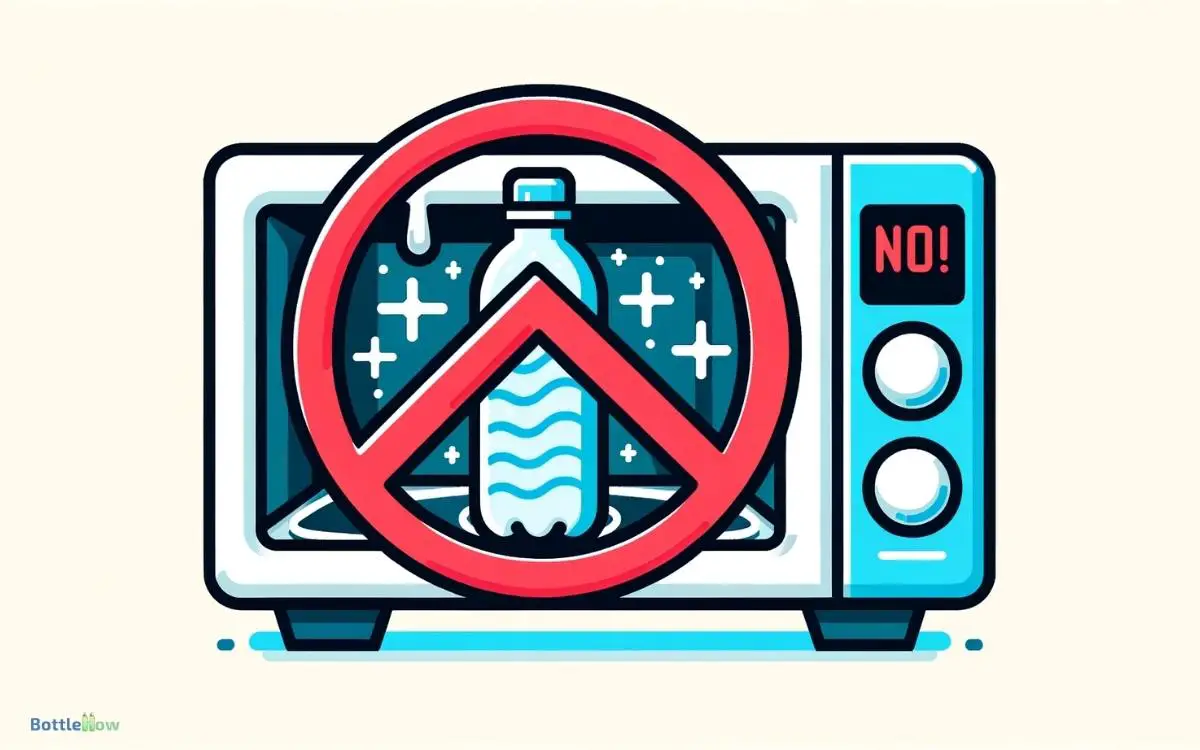Can You Put a Frozen Water Bottle in the Microwave? No!
You shouldn’t put a frozen water bottle in the microwave. Microwaves heat unevenly, causing rapid expansion of ice, which can lead to explosions and dangerously high temperatures.
Using plastic bottles increases the risk of chemical leaching, as some plastics release harmful chemicals like BPA and phthalates when heated.
Uneven heating can create dangerously hot spots, potentially causing burns or compromising the bottle’s integrity.
For safer alternatives, consider thawing your bottle at room temperature, in a cold water bath, or in the refrigerator.
Curious about the safest methods? Keep exploring for detailed guidance on thawing frozen water safely.

Key Takeaways
Microwave Safety Concerns
When considering whether to microwave a frozen water bottle, it’s important to understand the potential safety risks involved.
Microwaves heat unevenly, which can cause rapid expansion of ice inside the bottle. This uneven heating can create pressure buildup, leading to potential explosions.
Additionally, microwaving frozen water can result in dangerously high temperatures, posing burn risks.
Always make sure the microwave-safe label is present before proceeding. It’s vital to monitor the bottle closely if you choose to microwave it, and never leave it unattended.
Allowing the bottle to stand briefly post-microwave can help mitigate immediate temperature spikes.
By understanding these hazards, you can make an informed decision and prioritize safety when handling frozen water bottles in a microwave.
Plastic Bottle Hazards
In addition to the safety concerns with microwaving frozen water, you should also be aware of the hazards associated with plastic bottles. When you microwave plastic, chemicals like BPA and phthalates can leach into the water.
Even if a bottle is labeled microwave-safe, heating can degrade the plastic over time, increasing the risk of chemical contamination.
Not all plastics are created equal, and some may melt or release harmful substances when exposed to high temperatures.
It’s important to understand that these chemicals have been linked to health issues, including hormonal disruptions and potential carcinogenic effects.
To guarantee your safety, it’s best to avoid microwaving plastic bottles altogether and opt for alternatives like glass or microwave-safe containers.
Uneven Heating Issues
Microwaving a frozen water bottle can result in uneven heating, causing parts of the bottle to remain frozen while other areas become dangerously hot.
This happens because microwaves heat water molecules unevenly, especially in dense, frozen items.
You might think it’s a quick way to thaw your bottle, but the uneven distribution of heat can lead to spots that are extremely hot, potentially causing burns when you handle the bottle or take a sip.
Additionally, the plastic of the bottle can warp or even melt in these hot spots, compromising the bottle’s structural integrity.
To avoid these risks, it’s best to thaw frozen water bottles gradually at room temperature or under cold running water.
Potential Explosions
When you microwave a frozen water bottle, rapid heat expansion can cause significant risks. The steam pressure buildup inside the bottle might lead to an explosion, especially if the container’s structural integrity is compromised.
Always exercise caution to prevent dangerous situations.
Rapid Heat Expansion
Heating a frozen water bottle in the microwave can cause rapid heat expansion, potentially leading to dangerous explosions. When the ice inside the bottle starts to change from a solid to a liquid state, expanding in volume.
Microwaves heat unevenly, and this inconsistent heating can create hot spots, causing parts of the bottle to heat and expand faster than others. This swift expansion generates pressure inside the bottle.
Since the bottle is a closed container, the pressure has nowhere to go, increasing the risk of the bottle bursting.
You should avoid microwaving frozen water bottles to prevent these hazardous conditions. Always opt for safer methods to thaw frozen items, ensuring your safety and avoiding potential accidents.
Steam Pressure Buildup
Beyond the dangers of rapid heat expansion, steam pressure buildup within a microwaved frozen water bottle can also pose significant risks.
When you microwave a frozen bottle, the ice begins to melt and then boil, creating steam. This steam needs somewhere to go, and if the bottle is sealed or even partially closed, the pressure inside can increase rapidly.
As the steam can’t escape, the pressure may eventually cause the bottle to burst, potentially leading to an explosion. This can result in serious injuries from flying plastic shards or hot steam burns.
Always be cautious and avoid microwaving frozen water bottles to prevent such hazardous situations. Your safety is paramount when dealing with potential steam pressure buildup in microwaves.
Container Structural Integrity
Microwaving a frozen water bottle compromises its structural integrity, increasing the likelihood of the container rupturing under the intense heat. When you expose the plastic to rapid changes in temperature, it can become brittle and weak.
The frozen state of the water adds significant internal pressure as it changes from solid to liquid. This pressure, combined with the structural weakening, can lead to cracks or even explosions.
Additionally, many plastic bottles aren’t designed to withstand microwave temperatures, leading to potential leaching of harmful chemicals into the water. For safety, it’s best to avoid microwaving frozen water bottles altogether.
Instead, allow the bottle to thaw naturally or transfer the contents to a microwave-safe container.
Chemical Leaching Risks
When you microwave a frozen water bottle, you risk the chemicals from the plastic leaching into the water.
Plastics often contain compounds like BPA or phthalates, which can migrate into liquids when heated.
Even if your bottle is labeled ‘microwave-safe,’ extreme temperatures can still cause unwanted chemical reactions. These chemicals can be harmful if ingested over time, potentially leading to various health issues.
It’s important to understand that freezing and then microwaving creates temperature stress on the plastic, increasing the likelihood of leaching.
To minimize risks, transfer the frozen water into a microwave-safe, non-plastic container before heating.
Always prioritize safety by using materials designed to withstand both freezing and microwaving without compromising your health.
Microwave Damage
A frozen water bottle in the microwave can suffer structural damage, potentially causing it to crack or burst. When you expose a frozen bottle to sudden heat, the rapid temperature change creates stress in the plastic.
This stress can lead to:
- Cracking: The bottle’s material mightn’t handle the abrupt shift from freezing to warm.
- Leaking: Even minor fractures can result in leaks, creating a mess inside your microwave.
- Explosion: In extreme cases, pressure build-up from expanding ice can cause the bottle to burst.
Ensuring your frozen water bottle remains intact is essential. Always be cautious about subjecting plastic to rapid temperature changes. It’s safer to thaw the bottle at room temperature or in the refrigerator before considering microwave use.
Health Implications
Heating a frozen water bottle in the microwave could release harmful chemicals into your drink, posing potential health risks.
Many plastic bottles contain chemicals like BPA or phthalates, which can leach into the water when heated.
Exposure to these chemicals has been linked to various health issues, including hormonal disruptions and increased cancer risk.
Even if your bottle is labeled ‘microwave-safe,’ the extreme temperature changes from freezing to microwaving can cause the plastic to break down more quickly. It’s essential to be cautious, as the health implications of ingesting these chemicals can be significant.
You want to avoid any unnecessary exposure to potentially harmful substances, so consider alternative methods for thawing your frozen water bottle. Instead of using a microwave or hot water, try placing your frozen water bottle in the refrigerator for a slower, more controlled thawing process. This method helps maintain the bottle’s integrity and reduces the risk of harmful chemicals leaching into the water. If you’re traveling, be sure to check the frozen water bottle TSA rules to ensure compliance with security regulations at the airport.
Safe Thawing Methods
When thawing a frozen water bottle, you should consider safer alternatives to using a microwave.
You can leave it at room temperature, place it in a cold water bath, or let it thaw slowly in the refrigerator. These methods reduce the risk of damaging the bottle or causing uneven thawing.
Room Temperature Thawing
To safely thaw a frozen water bottle at room temperature, place it in a shallow dish to catch any condensation or spills. This method is straightforward but requires some patience.
Keep the bottle away from direct sunlight or heat sources, as these can cause uneven thawing and potential bottle deformation.
Consider these tips for effective room temperature thawing:
- Monitor regularly: Check the bottle every 30 minutes to make sure it’s thawing evenly.
- Rotate occasionally: Turn the bottle periodically to distribute the thawing process.
- Avoid sealed spaces: Don’t place the bottle in enclosed areas, as it needs adequate airflow.
Cold Water Bath
A cold water bath is an effective and safe method for thawing a frozen water bottle more quickly than room temperature thawing. To start, fill a container with cold tap water and submerge the frozen bottle.
Change the water every 30 minutes to maintain a consistent temperature. This method reduces the risk of bacterial growth compared to leaving it out at room temperature.
Here’s a quick comparison to highlight the benefits:
| Thawing Method | Time Required | Safety Level |
|---|---|---|
| Room Temperature | 2-3 hours | Moderate |
| Cold Water Bath | 1-2 hours | High |
| Microwave Defrosting | 10-15 minutes | Low |
Refrigerator Defrosting
Another reliable method for thawing a frozen water bottle is placing it in the refrigerator. This approach guarantees a slow and even thaw, minimizing the risk of the bottle cracking or leaking. It’s a safe method, but it requires some planning since it can take several hours.
Here’s why you might prefer this method:
- Safety: There’s no risk of the bottle overheating or causing a mess.
- Quality: The gradual thawing helps maintain the water’s taste and prevents any structural damage to the bottle.
- Convenience: Simply place the bottle in the fridge and go about your day without needing to monitor the process.
While it requires patience, using the refrigerator is a dependable way to thaw your frozen water bottle safely.
Conclusion
You might think microwaving a frozen water bottle is convenient, but it’s not worth the risk. The microwave can cause uneven heating, potential explosions, and even chemical leaching from the plastic.
Instead, use safer methods like thawing at room temperature, placing the bottle in a cold water bath, or letting it thaw in the refrigerator.
These methods may take longer, but they’re more reliable and guarantee your water remains uncontaminated and safe to drink.





